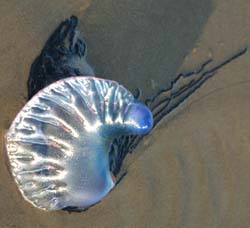|
Jellyfish are plentiful in the ocean and South Padre Island
has its share of them.
Fish are fish but what are jellyfish? They are not a fish.
They are not even close to being like a fish. But that is
how things get named in the sea. Much like a Dolphin being
called a Porpoise when they are very different animals, we
have local names for our creatures. We are satisfied with
the terms we all grew up with and that is why scientific names
in Latin are important when you want to be sure everyone is
talking about the same subject..
The jellyfish we call a cabbage head, with the scientific
name of Stomolophus meleagris, bob around quite harmlessly
growing up to the size of a soccer ball. The cabbage head
is a great source of food for certain sea turtles and host
a variety of fish in around their mushroom like caps. During
summer months they grow in size and wash up on shore to provide
food for many beach creatures and birds. Our dolphins are
often seen playing with them as if they were a ball. They
toss them back and forth between each other or push them around
on their tip of their mouths. Picking up one of these fine
jellyfish won’t sting like other jellyfish do. They
are beautiful to watch as they pulsate thru the water ever
so slowly.
Portuguese
man-o-war and Portuguese man-o-war fish in the fish
bowl.
These fish live in the tentacles of the man-o-war
and are immune to its sting.
|
|
The moon jelly ( Aurelia aurita) also washes ashore in large
groups and look like a flat clear pancake with a pink four
leaf clover shape inside of it, which is its stomach. They
have very short tentacles and are not as harmful as the sea
nettle. The sea nettle is a jellyfish that has long tentacles
and can give quite a sting. There are tiny hyperdermic type
needles called nematocysts, along the tentacles, which fire
off on contact and inject a substance that would normally
incapacitate a fish. For the human flesh it stings like fire.
Another jellyfish that packs a wallop is a sea wasp (Chiropsalmus
quadrumanus).
True to its name it is like being stung by wasps when coming
into contact with its tentacles. Some
jellies light up and are luminescent. The sea walnut (Beroe
ovata) is the size of a large pecan and if put in a cup of
water and watch carefully, the beautiful rows of colored lights
glow in a wave up and down the sides of the creature. They
are easily overlooked they are so clear and small.
 |
Jellyfish are not
too much of a problem here on South Padre but do watch
out for the purple bubble the Portuguese Man O War.
Its long purple tentacles sting with no mercy. It’s
best to just look and not touch these beautiful creatures.
We don’t want to have close encounters of the
stinging kind when around the ocean, but jellyfish are
wonderfully beautiful and mysterious creatures of the
sea.
Portuguese Man-O-War
Photo Nancy Patterson
|
( note: first aid for jellyfish - rinse with fresh water,
in most cases the sting may be treated with vinegar and unseasoned
meat tenderizer mixed in a paste, applied directly to the
sting. Reactions vary in individuals.) Scarlet and George Colley of South Padre
Island's "Fins
to Feathers" have been filming and documenting
their dolphins for eight years. They operate a tour business
on the Island and write seven articles a month for local papers
on the nature of the Island.
|